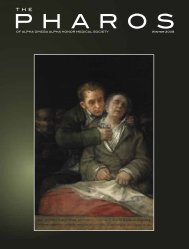The Pharos - Alpha Omega Alpha
The Pharos - Alpha Omega Alpha
The Pharos - Alpha Omega Alpha
Create successful ePaper yourself
Turn your PDF publications into a flip-book with our unique Google optimized e-Paper software.
<strong>The</strong> physician at the movies<br />
Left to Right: Alessandro Tiberi as Antonio, Roberto Della Casa as Uncle<br />
Paolo and Penélope Cruz as Anna in To Rome with Love.<br />
Photo by Philippe Antonello (c) Gravier Productions, Inc., Courtesy of Sony Pictures Classics<br />
results in women lining up to go to bed with him<br />
while his family is ignored. He enjoys the ride until<br />
the bitter and pathetic end.<br />
Topping off this mess is Alec Baldwin at his<br />
most pretentious and obnoxious best as John, an<br />
architect who, like the schnook, lived as a student<br />
in Rome decades before. He pops up periodically<br />
and tries to tell Jack not to get involved with the<br />
man-eater, while predicting what’s going to happen—as<br />
if we need him to tell us. My favorite<br />
scene was shot from the balcony of one of those<br />
hotels where one can enjoy a morning colazione<br />
while soaking up a spectacular view of Rome. If<br />
you have time to kill (and I do mean kill) see this<br />
movie; otherwise resist the temptation to view it<br />
at all costs.<br />
singing in the shower, where he sounds like Pavarotti. Allen’s<br />
character Jerry is an impresario who specializes in producing<br />
avant-garde operas that nobody wants to see. He immediately<br />
concocts a plan to get the mortician to translate his singing<br />
ability from the shower to the stage. I’ll leave it there.<br />
<strong>The</strong> second vignette involves a southern Italian couple who<br />
have come to Rome for their honeymoon, thinking that they<br />
may stay in the big city—even though the bride clearly prefers<br />
to go back home. Allen uses a weak contrivance to separate<br />
them, during which time they manage to have sex with others<br />
before they consummate their own marriage. In the groom’s<br />
case it’s with Anna, a bombshell prostitute played by Penelope<br />
Cruz in a dress that leaves little to the imagination. In the<br />
bride’s case it is ostensibly with a fat Italian movie star for<br />
whom she has always had a crush. <strong>The</strong> entry of a burglar and<br />
the film star’s jealous wife pushes the vignette beyond farce.<br />
Indeed, I found this to be the most far-fetched and offensive<br />
of the film’s vignettes.<br />
<strong>The</strong> third vignette features the omnipresent Woody Allen<br />
alter ego. Now that he can’t play the role himself, the presumably<br />
“lovable” schnook Jack is Jesse Eisenberg, whom I found<br />
to be obnoxious. An architectural student, he is in a live-in<br />
relationship that seems strong until his significant other, Sally<br />
(Greta Gerwig), while studying for an exam, throws him together<br />
with her visiting friend Monica (Ellen Page), a failed<br />
actress. Despite his protestations that he is not attracted to<br />
this man-eater, they have a steamy affair, all the while lamenting<br />
that they are doing this behind the friend’s back.<br />
<strong>The</strong> fourth vignette focuses on how reality television makes<br />
ordinary people celebrities who become famous for being famous.<br />
When the famous one is used up, he or she is replaced<br />
by another loser. Roberto Benigni, whose only claim to fame<br />
is his Academy Award performance in Life Is Beautiful, is<br />
insufferable as the nebbish Leopoldo who is married with two<br />
children. As his every waking minute is chronicled, his fame<br />
<strong>The</strong> Lost Weekend (1945)<br />
Starring Ray Milland, Jane Wyman, Phillip Terry, and Howard<br />
da Silva.<br />
Directed by Billy Wilder. Rated TV/PG. Running time 101 minutes.<br />
In the 1930s, following the repeal of Prohibition, drinking<br />
alcohol was portrayed in movies as relatively harmless and<br />
ubiquitous. Just think of the Thin Man films, where Nick<br />
Charles is rarely seen without a martini in his hand. After<br />
World War II, films turned dark (so-called film noir) and<br />
became grittier and more realistic. Based on Charles Jackson’s<br />
semi-autobiographical novel of the same name, 1 this film<br />
was the first to deal seriously with alcoholism. It also has the<br />
distinction of being one the many films of the time that were<br />
filmed on location in New York City—Naked City, A Double<br />
Life, Kiss of Death, On the Town, and Pickup on South Street<br />
among others—which added to the air of realism. Many scenes<br />
were filmed on Third Avenue, which was perpetually dark because<br />
of the Third Avenue EL or Elevated Line, which last ran<br />
on May 12, 1955, and was later dismantled. 2 <strong>The</strong> EL’s shadow,<br />
especially in the southern section of the Avenue called the<br />
Bowery, was the home of many homeless. This film shows<br />
that alcoholism wasn’t restricted to the lower social economic<br />
classes; it includes a scene in which the narrator points out a<br />
rich person, now a hopeless alcoholic.<br />
In the opening scene, the camera focuses on a bottle of<br />
whiskey hanging from a cord outside the apartment window<br />
of an alcoholic writer, Don Birnam (Ray Milland). He is being<br />
ushered off for a weekend in the country to cure his writer’s<br />
block by his solicitous brother, Wick Birnam (Phillip Terry),<br />
and girlfriend Helen St. John (Jane Wyman), but he wants no<br />
part of it. He has been dry for ten days and desperately wants<br />
36 <strong>The</strong> <strong>Pharos</strong>/Autumn 2012














